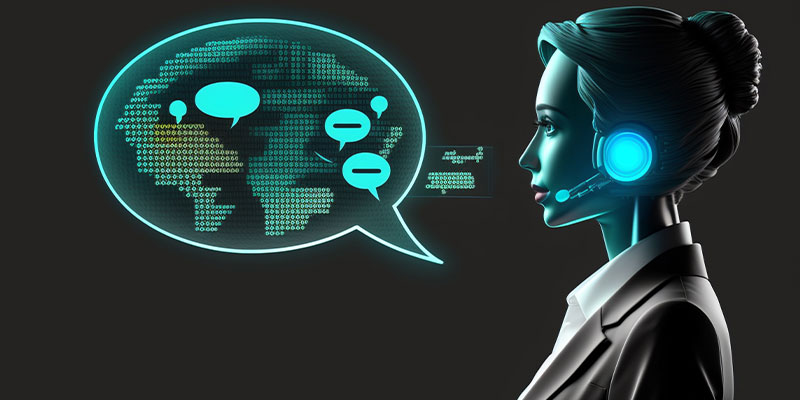Machine Translation (MT), which relies on complex machine learning algorithms, is a translation technology that has been in our lives for just over 50 years. It utilizes algorithms similar to Natural Language Processing and neural networks to dissect large quantities of data snappily, learn the different meanings of words, understand how words acquire meaning, and generate translations that are close to those produced by human translators.
Thanks to recent developments, AI translation has become a highly reliable tool for speeding up international launches, facilitating project management, and translating marketing content into the target language.
Although this translation makes the translation process faster and more efficient, the skills and linguistic abilities of human translators are still necessary and valuable. Human translators possess the ability to fully understand language and accurately translate it, which is essential in delivering high-quality translations.
What is AI Translation?
AI Translation leverages artificial intelligence to convert text or speech from one language to another, aiming to mirror human accuracy and understanding. Unlike traditional methods that solely depend on direct word-for-word translation, AI Translation incorporates the nuances of language, including context, dialects, and cultural implications, to provide more accurate and relatable translations.
The Journey from Manual to Machine Translation
The evolution of translation services has been remarkable. Initially, manual translation was the only method available, heavily reliant on bilingual or multilingual individuals to interpret texts or speech from one language to another. This process was time-consuming and fraught with the potential for errors, given the subjective understanding of the translator.
The introduction of machine translation marked a significant milestone, offering faster processing times but with limited success in accuracy. Early versions struggled with idioms, slang, and language nuances, often producing literal translations that missed the mark in terms of meaning and cultural relevance.
However, the advent of AI Translation has revolutionized this landscape. By incorporating machine learning and natural language processing, AI Translation systems can learn from vast amounts of data, continually improving their accuracy and fluency. This shift from manual to machine translation, powered by AI, represents a leap forward in our ability to communicate across language barriers.
Defining AI in the Context of Language Translation
AI, or artificial intelligence, refers to the simulation of human intelligence processes by machines, especially computer systems. In the context of language translation, AI involves using algorithms and machine learning models to understand, interpret, and translate languages. Unlike simpler translation tools, AI-powered systems can grasp context, recognize idioms, and adapt to different dialects, thereby offering translations that are not only accurate but also contextually appropriate and culturally sensitive.
How AI Translation Works
AI Translation operates through a combination of several advanced technologies, including natural language processing (NLP), machine learning (ML), and deep learning. NLP enables the system to understand the structure and meaning of the human language, while ML and deep learning allow it to learn from data, recognize patterns, and make informed predictions or decisions.
At its core, AI Translation involves feeding large datasets of text in multiple languages into a neural network, which learns to translate between languages. Over time, and with exposure to more data, these systems refine their understanding and improve their translation capabilities. They can also use context to decide the most appropriate translation for ambiguous words or phrases, significantly enhancing accuracy and fluency.

Advantages and Disadvantages
As with any innovation, translation with artificial intelligence has advantages and disadvantages. The advantages of artificial intelligence in translation are as follows:
- Speed: AI Translation can process large volumes of text or speech much faster than human translators, making it invaluable for urgent translations or real-time communication.
- Cost-effectiveness: By automating the translation process, AI reduces the need for human translators for initial drafts or straightforward documents, saving on costs.
- Accessibility: AI Translation breaks down language barriers, offering individuals and businesses the ability to communicate and access information in multiple languages easily.
- Continuous Improvement: With machine learning, AI Translation systems continually improve, learning from corrections and additional data to enhance accuracy and fluency over time.
The disadvantages of artificial intelligence in translation are as follows:
- Contextual Limitations: Despite advances, AI Translation can still struggle with highly context-dependent texts, such as poetry or nuanced literary works.
- Cultural Nuances: Capturing the subtleties of cultural expressions or idioms remains challenging, potentially leading to misunderstandings.
- Data Privacy: The need for large datasets to train AI systems raises concerns about data privacy and the use of sensitive or proprietary texts.
- Dependence on Quality Data: The quality of AI Translation is heavily reliant on the quality of the data it is trained on. Biased or inaccurate training data can lead to poor translations.
It is important to consider the advantages and disadvantages before translating with AI. Using AI for every translation does not necessarily mean that the result will always be good. That is why it is always better to seek professional service or consult someone.
Advancements in Neural Machine Translation (NMT)
Neural Machine Translation (NMT) is a form of AI translation that utilizes deep learning models to translate text. NMT systems learn from a vast corpus of bilingual text data, enabling them to understand context, grammar, and syntax of multiple languages. Unlike earlier forms of machine translation, NMT can generate more fluent and accurate translations by considering the entire input sentence, leading to outputs that are more aligned with how humans speak and write. This advancement has significantly improved the quality and efficiency of translations, making it possible to bridge communication gaps in real-time.
Challenges Faced by AI Technologies
Despite these advancements, AI translation technologies face several challenges. One of the primary issues is dealing with languages that have limited datasets available, which can hinder the system’s ability to learn and improve. Moreover, cultural nuances and idiomatic expressions often pose significant hurdles, as capturing the subtlety of language goes beyond mere word-for-word translation. Additionally, concerns regarding data privacy and the ethical use of AI technologies in translation persist, emphasizing the need for ongoing dialogue and regulation.
AI Translation Applications
AI translation has become increasingly popular among companies and sectors. It is widely used in various fields such as legal texts for international litigation, financial institutions including banks, e-commerce platforms, social networks, governments and public administrations, tourism and hospitality businesses, media and communication companies, translation agencies, and the printing/publishing industry. These translation applications play a significant role in translating legal documents, meeting the translation needs of financial institutions, translating product descriptions for e-commerce websites, and localizing social media content. This translation provides businesses with a fast, accurate, and cost-effective solution, facilitating communication and enabling access to global markets across diverse industries.
Evolution of AI Translation
AI translation, which entered our lives in its simplest form in the mid-1960s, has made significant progress ever since. The initial system developed was primarily used to generate draft translations to assist human translators. By the 1970s, rule-based MT was introduced. This rather simplistic system relied on a dictionary and a set of grammar rules to perform word-by-word translations. However, the resulting translations were often erroneous or incomprehensible.
Subsequently, statistical MT came into play. This technology compared the content restated by mortal translators and organized all the rules with the help of algorithms. SMT significantly improved the quality of machine translation, although it still lacked reliability and required human intervention.
In the 1990s, the era of statistical model-based MT began. Despite being a significant step forward, this method still exhibited noticeable errors.
In 2017, with the advent of artificial intelligence, MT experienced a groundbreaking leap. Developments achieved through neural networks and AI applications were considered significant milestones in the field of translation.
In the subsequent years, statistical and probability-based approaches were surpassed. Presently, AI-based translation systems operate using neural networks and artificial computer processing that mimic the connections between neural cells in the human brain.
AI Translation and the Future of Communication
AI translation is poised to play a pivotal role in the future of communication, enabling more seamless interaction across linguistic boundaries. Its integration into various platforms, from social media to business communication tools, suggests a future where language barriers become increasingly transparent. As AI technologies continue to evolve, the potential for real-time, accurate, and context-aware translations could transform global communication, making it more inclusive and accessible.
Will Human Translation Still Matter?
Despite the strides in AI translation, the role of human translators remains critically important. Human expertise is essential for tasks that require deep understanding of cultural context, creative expression, and nuanced language. Moreover, human translators play a vital role in training and refining AI systems, ensuring translations are not only accurate but also culturally sensitive. The synergy between human expertise and AI technologies represents a collaborative future where each complements the other.
The Difference Between AI Translation and Machine Translation
The distinction between AI translation and traditional machine translation lies in their approach and capabilities. Traditional machine translation, often rule-based or statistical, translates text based on fixed algorithms or statistical models without understanding context. In contrast, AI translation, particularly through NMT, employs deep learning to process and understand languages in a more holistic manner, considering context, syntax, and semantics. This results in translations that are not just accurate but also contextually relevant and fluid.



